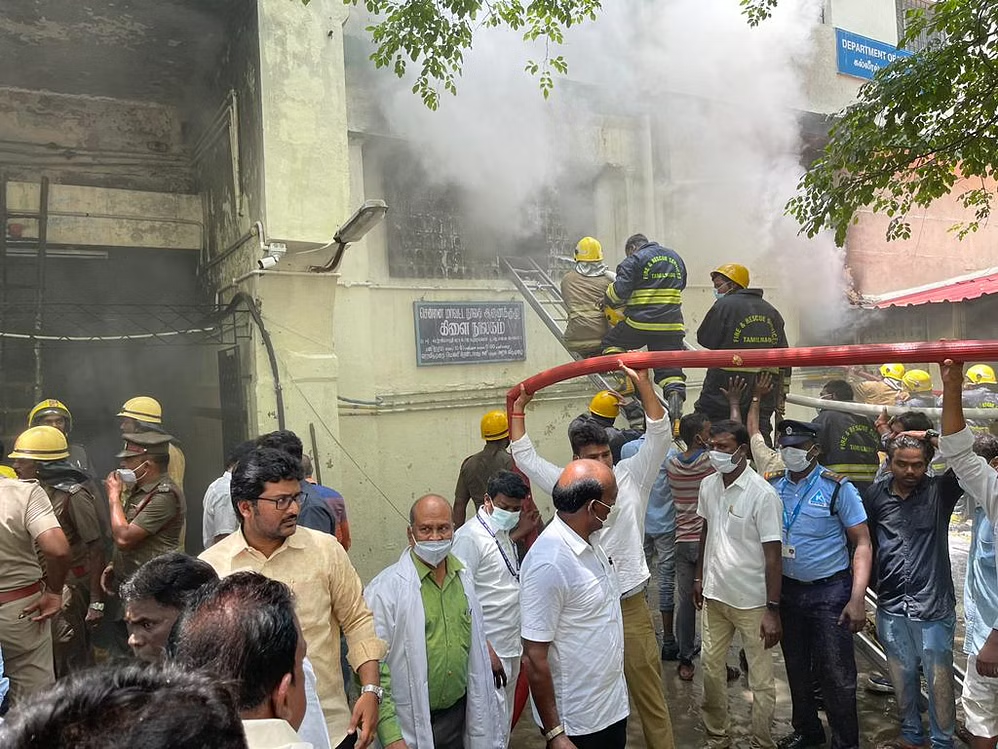Walking into fire traps
Two of the 10 oxygen cylinders that were stored in this room had also exploded, a development that could have spiralled into a disaster, if not for the timely action of the fire tenders.

Chennai: In the aftermath of a fire that broke out at the Rajiv Gandhi Government General Hospital last week, the question of fire and building safety and periodic audits at public health institutions has re-emerged. While 128 patients, including the critically ill were evacuated, it was pure providence that there were no casualties in the accident. The fire had originated in a store room due to an electrical short circuit. Two of the 10 oxygen cylinders that were stored in this room had also exploded, a development that could have spiralled into a disaster, if not for the timely action of the fire tenders.
In the RGGGH case, experts had pointed out that patients were still housed in the building that is more than a century old despite the availability of three new multi-storeyed towers. The accident at this government hospital, which is considered to be one of Tamil Nadu’s most reputed medical establishments, points to a historically negligent attitude when it comes to aspects of safety, in such public places. Even one year ago, the Kasturba Gandhi Hospital for Women and Children had witnessed an episode of fire triggered by a short-circuit, which necessitated the evacuation of pregnant women, new mothers and children. Hospital fires are all too common across India, and had come into focus during the start of the pandemic.
In Gujarat, hospital fires claimed the lives of 24 patients in two separate incidents that took place in Ahmedabad and Bharuch in August 2020 and May 2021 respectively. In January 2021, a fire at the Bhandara Civil Hospital in Maharashtra witnessed the deaths of 10 babies, while in November, a hospital fire in Ahmednagar had claimed the lives of ten people. Put together, in a span of 20 months, India lost 122 patients to 29 incidents of hospital fires, of which 12 incidents involved government hospitals.
In the backdrop of the RGGGH incident, it is essential to understand what causes such accidents to occur repeatedly, and how we could remedy the situation. Firstly, there is an absence of design thinking – most hospitals in India are built with a philosophy of functionality over form, as a measure to keep costs minimal. More real estate space and better fixtures entail additional expenditure. At the waiting area of any minor or midscale health facility, one can find people not just seated but standing.
Some institutions have corridors that can barely accommodate two adults, side by side, let alone leave space for emergency evacuation. Then, there’s the question of the materials used for construction and the nature of medical equipment, many of which are flammable. Most clinics use false ceilings to provide centralised air conditioning as well as oxygen supply. However, the materials used in such false ceilings are noxious when exposed to flames. The oxygen cylinders are also a major fire hazard.
As per a study by the International Journal of Community Medicine and Public Health released in 2020, of the 33 hospitals where fire accidents took place between 2010-2019, just about 19 had an operational firefighting system in place. As per the National Building Code of India, hospitals are categorised under C1, i.e. buildings that need special infrastructure for fire safety. These include fire lifts, smoke detectors, extinguishers, ventilation ducts and insulation of electrical fittings using non-combustible materials.
Two years ago, the Supreme Court had also instructed all states to undertake fire audits in all COVID-19 hospitals as well and appoint nodal officers to oversee aspects of fire safety compliance. Unfortunately, many hospitals bypass such norms. Several accidents can be avoided if simple measures entailing common sense can be followed. The State government must accord this incident the attention that is due and ensure such accidents do not repeat.
Visit news.dtnext.in to explore our interactive epaper!
Download the DT Next app for more exciting features!
Click here for iOS
Click here for Android



